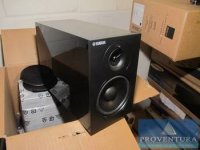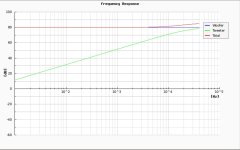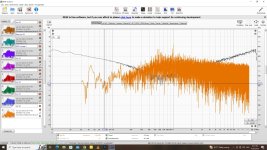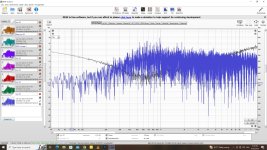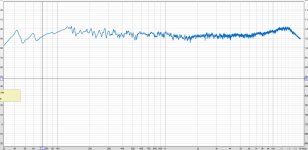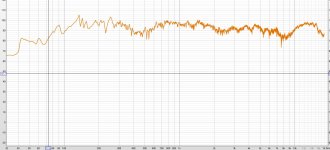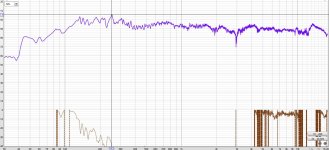Hello , im new on this forum .
I am Audio Doctor , i work with audio files , repair damage , remove noise , do Mastering and such .
But i got some listening speakers .
Since my room is small , i got small speakers , couple of them but for this time Yamaha BP NS 110
Very nice speaker, very fast , has nothing on the woofer goes directly to the amp , its a 3-4 inch woofer says 6 ohms measured 3.5Ohms DC , hence its fast .But it doesnt go low , about 60hz with box 50hz. Yet to be measured .
And on the tweeter it has 1uF (microFarad ) Capacitor in series , i trust its not very god one , but i measured the value at 1.24 uF and the tweeter is 6ohms , measured 6ohms .
Of course this is DC .
Now when i enter those values in Crossover calculator , i get 22khz cut off , that is impossible , because i hear the tweeter
So we have bass going directly to the amp , and in parallel with the tweeter that has a capacitor 1.24 uF in series on it .
I have measuring gear , and will ultimately measure it .
But if someone could help me with this calculation , one im doing is obviously wrong .
I opened up the speaker , immediately , since im very good in Electro Acoustics , in fact i have bachelors degree in Electroacoustics .
I saw it has bracing , but is not filled with foam of some kind , so i filled it up .
The reason Foam is put in , is because sound travels slower in harder material , so basically with putting foam in it you get bigger speaker , sound wise .
I also used kind of Rubber metallic sandwich that is labeled Ground Zero and used in cars , so that Car doors and such dont vibrate , its antivibration tool
I added a bit of that , bad thing is that it effecticly makes the box smaller , but i added a foam , so i guess im at equals now , but i have notices much tighter sound .
So it works .
its all good .
But now to the Crossover , there is lots to say about them , but complex big crossovers eat up transients in sound , so i avoid them you may not , its my preference , and use only small 2 way speakers that can go without crossover , with only capacitor on the tweeter to filter out the bass and mids to extent .
Now can someone calculate for me the Crossover frequency
Bass unit says 6ohms but i measured it at 3.5ohms DC ... disconnected from tweeter of course .
So that you have all the info that you need .
Ultimetly i plan to measure them , and maybe add difrent Capacitors a matched pair , and maybe a small coil on Bass driver , i dont want to go big there not to eat up the transients .
I used to make Valve Amplifiers with Transformers on the output , so there i learned how bad it is for transients , mostly higher frequency's but also low in case of Valve amplifiers i didnt get the bass at all , so i use Valve Preamps . That can go without transformers hence has bass .
So if anyone can help me with the Crossover much appreciated .
I am Audio Doctor , i work with audio files , repair damage , remove noise , do Mastering and such .
But i got some listening speakers .
Since my room is small , i got small speakers , couple of them but for this time Yamaha BP NS 110
Very nice speaker, very fast , has nothing on the woofer goes directly to the amp , its a 3-4 inch woofer says 6 ohms measured 3.5Ohms DC , hence its fast .But it doesnt go low , about 60hz with box 50hz. Yet to be measured .
And on the tweeter it has 1uF (microFarad ) Capacitor in series , i trust its not very god one , but i measured the value at 1.24 uF and the tweeter is 6ohms , measured 6ohms .
Of course this is DC .
Now when i enter those values in Crossover calculator , i get 22khz cut off , that is impossible , because i hear the tweeter
So we have bass going directly to the amp , and in parallel with the tweeter that has a capacitor 1.24 uF in series on it .
I have measuring gear , and will ultimately measure it .
But if someone could help me with this calculation , one im doing is obviously wrong .
I opened up the speaker , immediately , since im very good in Electro Acoustics , in fact i have bachelors degree in Electroacoustics .
I saw it has bracing , but is not filled with foam of some kind , so i filled it up .
The reason Foam is put in , is because sound travels slower in harder material , so basically with putting foam in it you get bigger speaker , sound wise .
I also used kind of Rubber metallic sandwich that is labeled Ground Zero and used in cars , so that Car doors and such dont vibrate , its antivibration tool
I added a bit of that , bad thing is that it effecticly makes the box smaller , but i added a foam , so i guess im at equals now , but i have notices much tighter sound .
So it works .
its all good .
But now to the Crossover , there is lots to say about them , but complex big crossovers eat up transients in sound , so i avoid them you may not , its my preference , and use only small 2 way speakers that can go without crossover , with only capacitor on the tweeter to filter out the bass and mids to extent .
Now can someone calculate for me the Crossover frequency
Bass unit says 6ohms but i measured it at 3.5ohms DC ... disconnected from tweeter of course .
So that you have all the info that you need .
Ultimetly i plan to measure them , and maybe add difrent Capacitors a matched pair , and maybe a small coil on Bass driver , i dont want to go big there not to eat up the transients .
I used to make Valve Amplifiers with Transformers on the output , so there i learned how bad it is for transients , mostly higher frequency's but also low in case of Valve amplifiers i didnt get the bass at all , so i use Valve Preamps . That can go without transformers hence has bass .
So if anyone can help me with the Crossover much appreciated .
Attachments
No, it is a slow rolloff. Maybe the tweeter is higher sensitivity so it is good at low treble and has a slight tilt upward?i get 22khz cut off , that is impossible
Yes, your calculation is correct.. but a tweeter that measures 6 ohms is often an 8 ohm device. However, it is often 6 ohms closer to the cross. However, not so much at 22kHz.
What method are you using to plot this? Are you considering using a simulator?
What method are you using to plot this? Are you considering using a simulator?
i will download REW if that is the measuring softeware name , and measure it . But it may take some time .
The 4" will probably play to 5kHz or 10kHz. The tweeter is just to fill in. Not sure if it can handle other ways of crossing.
Here i tested them Blue one is Yamaha , orange one is Studio monitor Behringer 2031A with 8,5inch bass unit with double magnets and front ported , yamaha is back ported . . We can se the Resemblance , so this is not the speaker this is my room and the speaker , but on average its the room like i have said many times its the room you hear , i have 387x393x 247 Cm Room , its bad , no Acoustic treatment done
My sound interface may have a role in this as well , because i was not able to get a good calibration file , i don't know why , i had input and output at red basically , and when it does the calibration it says its -48db and for accurate calibration above -35 is needed . But i have it blasted as much as i can , i have level meters on the interface , so if i pushed it more it would start distorting , so i don't know why is that , maybe i find solution to that problem ,maybe i should have done the calibration at all , because i know the interface to be in these circumstances basically flat , can be expected to be flat ,because we have major players here , interface being the smallest input of all of them .
My sound interface may have a role in this as well , because i was not able to get a good calibration file , i don't know why , i had input and output at red basically , and when it does the calibration it says its -48db and for accurate calibration above -35 is needed . But i have it blasted as much as i can , i have level meters on the interface , so if i pushed it more it would start distorting , so i don't know why is that , maybe i find solution to that problem ,maybe i should have done the calibration at all , because i know the interface to be in these circumstances basically flat , can be expected to be flat ,because we have major players here , interface being the smallest input of all of them .
Attachments
And i didnt say , Yamaha is on Valve preamp , Ayima t4 , so this proves its good , i did the measurements before this is not my first time , and i know how bad they can be , especially valve amps .For a valve preamp this is very good . But far from extensive measurements . Just a preview .
If someone has an idea how i can improve these Yamaha speakers still , i would appreciate that .
If someone has an idea how i can improve these Yamaha speakers still , i would appreciate that .
I have fixed the issues with the measurements , the calibration file and the reason i didn't get loud enough input is because i chose wrong input , but to my defense , on the interface it says input 1 , turns out software registers that as input 2 . So the measurements were actually cross talk , so will fix that now and add , Behringer 2031A and Philips MCD 708 . I have also measured close , 10Cm , its not realistic , but to get the room out of equation , its still not out of equation because i noticed similarities in the response , so all similarities are to be discarded as being effects of room , position , and audio interface , as reference ive took Studio monitors that i know to be flat to + - 1,5dB. So you can use that as reference as well
Studio Monitor measurements 10cm , in blue . Yamaha right 10cm orange , left green . And Philips MCD 708 in purple .
Initially i have tested with my ears MCD708 , and didnt like it , found them dark . But actually measruments say its better then Yamaha , almost flat and wiht little phase issues , only issue is a null of about 10-18dB at 3Khz , maybe that is why i took them as dark . Bass levels match the Yamaha , but Yamaha is more sensitive , its about 1/5 louder , dont know how much is that in dB , probably around 2dB , so if Yamahas are 89dB sensitivity , Philips MCD 708 is 87dB , 2 dB doesnt sound much , but 6dB is double , so when i placed one Yamaha and one Philips i had to take my ear to Philps to see if it is working , i litrally heard left yamaha even tho i was closer to the right as i was hooking the cable . So they are definatly less sensitive , but that is not an issue , for i have 80% more power then i need . And one more thing , all speakers except studio monitors are run over Valve amplifier with Class D output Ayima T4 that if you ask me , is a good device . Does not give too much Valve sound like Valve amp would do , but you keep the bass . I have made Valve amps and preamps and tested them , my homemade preamp lacked bass *** well , i think this is due to high Voltage levels , Voltage levels on the tube give you the Tube sound , the higher the voltage the more Valve sound you get , commonly its around 300-400V , that you then have to turn in to current over transformers where you bass is lost and not only that , and also in my preamps turning that down caused bass issues as well , not as much as Amp but still . These Chinese low Voltage tubes , they are a very good balance . if you want Valve sound , but still listen to modern music like i do with bass .
Initially i have tested with my ears MCD708 , and didnt like it , found them dark . But actually measruments say its better then Yamaha , almost flat and wiht little phase issues , only issue is a null of about 10-18dB at 3Khz , maybe that is why i took them as dark . Bass levels match the Yamaha , but Yamaha is more sensitive , its about 1/5 louder , dont know how much is that in dB , probably around 2dB , so if Yamahas are 89dB sensitivity , Philips MCD 708 is 87dB , 2 dB doesnt sound much , but 6dB is double , so when i placed one Yamaha and one Philips i had to take my ear to Philps to see if it is working , i litrally heard left yamaha even tho i was closer to the right as i was hooking the cable . So they are definatly less sensitive , but that is not an issue , for i have 80% more power then i need . And one more thing , all speakers except studio monitors are run over Valve amplifier with Class D output Ayima T4 that if you ask me , is a good device . Does not give too much Valve sound like Valve amp would do , but you keep the bass . I have made Valve amps and preamps and tested them , my homemade preamp lacked bass *** well , i think this is due to high Voltage levels , Voltage levels on the tube give you the Tube sound , the higher the voltage the more Valve sound you get , commonly its around 300-400V , that you then have to turn in to current over transformers where you bass is lost and not only that , and also in my preamps turning that down caused bass issues as well , not as much as Amp but still . These Chinese low Voltage tubes , they are a very good balance . if you want Valve sound , but still listen to modern music like i do with bass .
Attachments
- Home
- Design & Build
- Construction Tips
- Yamaha BP110 help with Crossover
